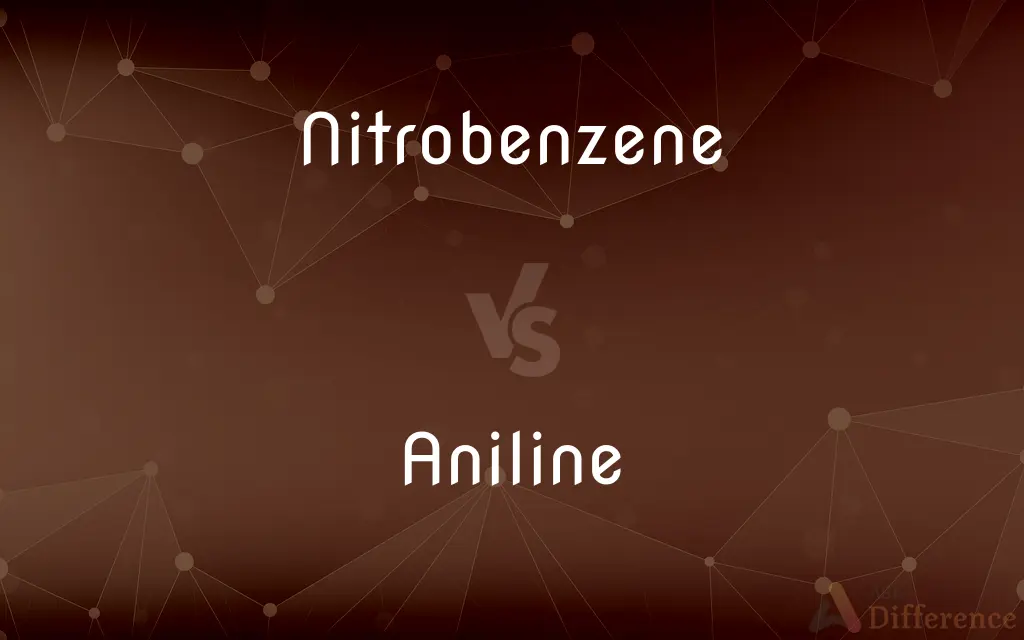Nitrobenzene vs. Aniline — What's the Difference?
By Tayyaba Rehman — Updated on September 27, 2023
Nitrobenzene is a chemical compound (C6H5NO2) used as a precursor to aniline. Aniline is an organic compound (C6H5NH2) and is a building block in the synthesis of dyes, pharmaceuticals, and polymers.

Difference Between Nitrobenzene and Aniline
Table of Contents
ADVERTISEMENT
Key Differences
Nitrobenzene and Aniline are both organic compounds with crucial roles in chemical synthesis, notably serving different purposes and applications. Nitrobenzene, characterized by a nitro group (-NO2) attached to a benzene ring, is a yellow, oily, aromatic nitro compound, primarily utilized as an intermediate in the production of aniline. Its applications extend to the synthesis of chemicals like pesticides and synthetic resins, demonstrating its utility in the chemical industry.
Aniline, derived from nitrobenzene, consists of an amino group (-NH2) attached to a benzene ring, and is a significant component in the production of dyes, pharmaceuticals, and polymers. It is a precursor to many industrial chemicals and is widely recognized for its versatility in chemical synthesis, offering extensive utility in varied industrial applications, from rubber processing chemicals to isocyanates used in polyurethane manufacturing.
While nitrobenzene acts as a precursor and is vital for the production of aniline, the latter is integral to multiple synthetic processes, leading to the formulation of numerous industrial chemicals and products. The transformation of nitrobenzene to aniline involves a reduction reaction, emphasizing the interconnected nature of these compounds in chemical synthesis pathways.
In essence, nitrobenzene is a foundational chemical, crucial for producing aniline, which in turn, serves as a versatile building block in the synthesis of a diverse array of chemicals, dyes, and pharmaceuticals. The functional differences between these compounds underscore their distinct roles and impacts in chemical and industrial domains.
Comparison Chart
Formula
C6H5NO2
C6H5NH2
ADVERTISEMENT
Group Attached
Nitro group (-NO2)
Amino group (-NH2)
Uses
Intermediate in the production of aniline
Used in the production of dyes, pharmaceuticals, and polymers
Product Formation
Acts as a precursor to aniline
Formed from the reduction of nitrobenzene
Applications
In the synthesis of chemicals like pesticides and synthetic resins
In the synthesis of varied industrial chemicals and products
Compare with Definitions
Nitrobenzene
It has the chemical formula C6H5NO2 and features a nitro group attached to a benzene ring.
The presence of a nitro group in nitrobenzene makes it a critical component in chemical reactions leading to aniline production.
Aniline
It serves as a precursor to many industrial chemicals, including isocyanates used in polyurethane manufacturing.
The synthesis of numerous chemicals, such as isocyanates, relies on the availability of aniline.
Nitrobenzene
It acts as an intermediate chemical in the production of aniline.
The synthesis of aniline involves the reduction of nitrobenzene, demonstrating their interconnected roles in chemical processes.
Aniline
An organic compound used as a building block in the synthesis of dyes, pharmaceuticals, and polymers.
Aniline’s role in synthesizing various industrial products makes it a valuable chemical in manufacturing processes.
Nitrobenzene
It is aromatic and is known for its distinctive, sweet, almond-like odor.
Workers handling nitrobenzene are advised to use protective gear due to its toxic nature and strong odor.
Aniline
It is derived from nitrobenzene through a reduction reaction.
The production of aniline from nitrobenzene is a crucial step in the manufacture of diverse chemical products.
Nitrobenzene
A yellow oily liquid compound used primarily as a precursor to aniline.
Nitrobenzene is utilized extensively in the chemical industry due to its role in the synthesis of aniline.
Aniline
It has the chemical formula C6H5NH2 and features an amino group attached to a benzene ring.
The structure of aniline, with its amino group, allows it to participate in a wide range of chemical reactions.
Nitrobenzene
Utilized in the synthesis of various chemicals including pesticides and synthetic resins.
The versatility of nitrobenzene is evident in its widespread use in producing diverse chemical products.
Aniline
It is a vital component in the rubber processing chemicals industry.
The production of rubber-related products often involves the use of aniline due to its reactive nature.
Nitrobenzene
Nitrobenzene is an organic compound with the chemical formula C6H5NO2. It is a water-insoluble pale yellow oil with an almond-like odor.
Aniline
Aniline is an organic compound with the formula C6H5NH2. Consisting of a phenyl group attached to an amino group, aniline is the simplest aromatic amine.
Nitrobenzene
A colorless or yellowish poisonous oily liquid, C6H5NO2, having the odor of almonds and used in the manufacture of aniline, insulating compounds, and polishes.
Aniline
A colorless, oily, poisonous benzene derivative, C6H7N, used in the manufacture of rubber, dyes, resins, pharmaceuticals, and varnishes.
Nitrobenzene
(organic compound) A nitro derivative of benzene, C6H5NO2, prepared by reacting benzene with a mixture of nitric and sulphuric acids; any of a series of such compounds having two or more nitro groups
Aniline
Derived from aniline.
Nitrobenzene
A yellow aromatic liquid (C6H5.NO2), produced by the action of nitric acid on benzene, and called from its odor imitation oil of bitter almonds, or essence of mirbane. It is used in perfumery, and is manufactured in large quantities in the preparation of aniline. Fornerly called also nitrobenzol.
Aniline
(organic compound) The simplest aromatic amine, C6H5NH2, synthesized by the reduction of nitrobenzene; it is a colourless oily basic poisonous liquid used in the manufacture of dyes and pharmaceuticals.
Nitrobenzene
A poisonous oily water-soluble liquid used as a solvent and in the manufacture of aniline
Aniline
An organic base belonging to the phenylamines. It may be regarded as ammonia in which one hydrogen atom has been replaced by the radical phenyl. It is a colorless, oily liquid, originally obtained from indigo by distillation, but now largely manufactured from coal tar or nitrobenzene as a base from which many brilliant dyes are made.
Aniline
Made from, or of the nature of, aniline.
Aniline
Oily poisonous liquid amine obtained from nitrobenzene and used to make dyes and plastics and medicines
Common Curiosities
What is Aniline primarily used for?
Aniline is primarily used as a precursor to polymers and is instrumental in the synthesis of chemicals used in rubber, dyes, and pharmaceuticals.
Is Nitrobenzene used as a solvent?
Yes, nitrobenzene is used as a solvent, particularly for electrophilic reagents in chemical reactions.
Is Nitrobenzene an aromatic compound?
Yes, nitrobenzene is an aromatic compound derived from benzene, consisting of a nitro group (NO2) attached to a benzene ring.
Can Aniline be obtained from nitrobenzene?
Yes, aniline can be synthesized by reducing nitrobenzene, typically using hydrogen in the presence of a catalyst.
Is Aniline a base?
Yes, aniline is a weak base due to the presence of an amino group, but its basicity is weaker than typical amines due to resonance stabilization.
Is Nitrobenzene toxic?
Yes, nitrobenzene is toxic and can be absorbed through the skin, causing symptoms like headache, dizziness, and even cyanosis, characterized by a blue coloration of the skin.
Is Aniline soluble in water?
Aniline has limited solubility in water due to its hydrophobic benzene ring but can be dissolved in organic solvents.
Is Nitrobenzene flammable?
No, nitrobenzene is not flammable but is considered hazardous due to its toxicity and environmental impact.
Can Nitrobenzene be reduced to form phenylamine?
Yes, nitrobenzene can be reduced to form phenylamine, another name for aniline, using reduction processes.
How is Nitrobenzene produced?
Nitrobenzene is typically produced by nitration of benzene, involving a reaction with concentrated nitric acid and sulfuric acid.
How is Aniline classified in terms of organic chemistry?
Aniline is classified as an aromatic amine because it has an amino group attached to a benzene ring.
Is Aniline harmful?
Yes, aniline is harmful and can cause several health issues, including methemoglobinemia, characterized by an impaired ability of the blood to transport oxygen.
Does Aniline have a distinct smell?
Yes, aniline has a characteristic fishy odor and is sometimes referred to as aminobenzene or phenylamine.
Is Nitrobenzene used in the synthesis of aniline?
Yes, nitrobenzene is a precursor to aniline and is reduced to produce aniline through a chemical reaction.
Can Nitrobenzene cause environmental pollution?
Yes, nitrobenzene is an environmental pollutant and can contaminate water and soil, posing risks to aquatic life and ecosystems.
Share Your Discovery

Previous Comparison
Comply vs. Obey
Next Comparison
Shine vs. ShininessAuthor Spotlight
Written by
Tayyaba RehmanTayyaba Rehman is a distinguished writer, currently serving as a primary contributor to askdifference.com. As a researcher in semantics and etymology, Tayyaba's passion for the complexity of languages and their distinctions has found a perfect home on the platform. Tayyaba delves into the intricacies of language, distinguishing between commonly confused words and phrases, thereby providing clarity for readers worldwide.















































